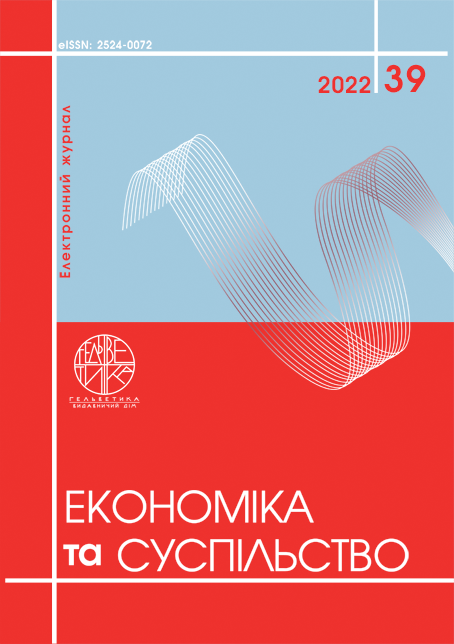STRATEGIES FOR USING DIGITAL TOOLS IN SMALL AND MEDIUM BUSINESSES DURING THE ECONOMIC CRISIS
Abstract
The article examines new technological trends in digitalization processes related to small and medium-sized businesses (SMEs), which proves that the current crisis and its consequences will undoubtedly accelerate the digitalization of Ukrainian business. Digital transformation and innovation of business models have radically changed the expectations and behaviour of consumers, affected traditional forms of entrepreneurship, and transformed the activities of many economic systems. The author studies the trends and opportunities for digitalization of small and medium-sized businesses. These circumstances intensify the development of SMEs, which is one of the leading sectors of the economy, which determines the rate of economic growth, composition, and quality of gross national product, and has every opportunity to respond flexibly to market needs and changing economic conditions. The current state and features of digitalization of Ukraine's economy are analysed. The article emphasizes that the insights made by SMEs leaders as a result of both the pandemic and the Russian-Ukrainian war will determine the fate of their companies and the entire national economy in both the short- and long-term perspective. The article analyses the main strategic directions of the introduction of digital tools in the activities of companies and presents the key characteristics of digitization, digitalisation, and digital transformation. The article proposes to solve the problem of digitalization of SMEs through the using joint effective management solutions and information system for finding and selecting effective and affordable digital projects for implementation in the small and medium business sector. The article considers that the digitalization of small and medium enterprises has some features that are both their advantages and disadvantages, compared with large forms of business organization. Exploring these features and finding ways to use the positive aspects that will overcome the impact of negative aspects, will increase the level of digitization of small businesses and, consequently, the level of innovation of the economy.
References
Adapting population skills to the post-pandemic economy in fergana valley. URL: https://www.undp.org/uzbekistan/projects/adapting-population-skills-post-pandemic-economy-fergana-valley (дата звернення: 14.05.2022).
Juhani et al. Mapping Business Transformation in Digital Landscape: A Prescriptive Maturity Model for Small Enterprises. Communications in computer and information science. 2018. № 907. Р. 101–116. URL: https://www.springerprofessional.de/en/ mapping-business-transformation-in-digital-landscape-a-prescript/16029438 (дата звернення: 25.05.2022).
Звіт Глобального центру з цифрової трансформації бізнесу: Digital Vortex. How Digital Disruption Is Redefining Industries. URL: https://www.cisco.com/c/dam/en/us/solutions/collateral/industry-solutions/digital-vortexreport.pdf (дата звернення: 05.05.2022).
Digital transformation scoreboard 2018: EU businesses go digital: opportunities, outcomes and uptake. Luxembourg: Publications Office of the European Union. 2018. URL: https://ec.europa.eu/growth/tools-databases/dem/monitor/scoreboard (дата звернення: 01.06.2022).
Digital Economy and Society Index 2021: overall progress in digital transition but need for new EU-wide efforts. URL: https://ec.europa.eu/commission/presscorner/detail/en/ip_21_5481 (дата звернення: 02.06.2022).
Іванченко Н., Кудрицька Ж., Рекачинська К. Бізнес-моделі в умовах цифрових трансформацій. Вчені записки ТНУ імені В. І. Вернадського. Серія: Економіка і управління. 2020. № 3. Т. 31. С. 185–190.
Gorokhova T., Mamatova L. Distinctives of the learning process transformation through digital tools: challenges and opportunities. Organization and management in the services’ sphere on selected examples. Monograph. – Opole: The Academy of Management and Administration in Opole, 2020. P. 230–241.
Adapting population skills to the post-pandemic economy in fergana valley. URL: https://www.undp.org/uzbekistan/projects/adapting-population-skills-post-pandemic-economy-fergana-valley (accessed: May 14, 2022).
Juhani et al. Mapping Business Transformation in Digital Landscape: A Prescriptive Maturity Model for Small Enterprises. Communications in computer and information science. 2018. № 907. Р. 101–116. URL: https://www.springerprofessional.de/en/ mapping-business-transformation-in-digital-landscape-a-prescript/16029438 (accessed: May 25, 2022).
Zvit Hlobalnoho tsentru z tsyfrovoi transformatsii biznesu: Digital Vortex. How Digital Disruption Is Redefining Industries. URL: https://www.cisco.com/c/dam/en/us/solutions/collateral/industry-solutions/digital-vortex-report.pdf (accessеd: May 05, 2022).
Digital transformation scoreboard 2018: EU businesses go digital: opportunities, outcomes and uptake. Luxembourg: Publications Office of the European Union. 2018. URL: https://ec.europa.eu/growth/tools-databases/dem/monitor/scoreboard (accessеd: June 01, 2022).
Digital Economy and Society Index 2021: overall progress in digital transition but need for new EU-wide efforts URL: https://ec.europa.eu/commission/presscorner/detail/en/ip_21_5481 (accessеd: June 02, 2022).
Ivanchenko N. Kudryts'ka Zh. and Rekachyns'k, K. (2020) Biznes-modeli v umovakh tsyfrovykh transformatsiy [Business models in the conditions of digital transformations]. Vcheni zapysky TNU imeni V. I. Vernads'koho. Seriia: Ekonomika i upravlinnia, vol. 3, no. 31, pp. 185–190.
Gorokhova T., Mamatova L. Distinctives of the learning process transformation through digital tools: challenges and opportunities. Organization and management in the services’ sphere on selected examples. Monograph. – Opole: The Academy of Management and Administration in Opole, 2020. P. 230–241.


